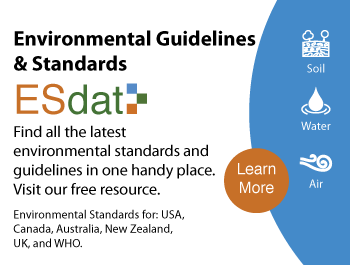The Saskatchewan Environmental Quality Guidelines provides the desired concentration of substances in the environment to enforce the protection of pathways. It includes protection of water, air, soil and sediments. The pathway-specific criteria applied in the guidelines are informed by the Canadian Council of Ministers of the Environment. The Ministry of Environment is responsible for the development of quality guidelines. The criteria cover human health and ecological exposure. Human health pathways include:
- Soil dermal contact.
- Soil ingestion.
- Protection of potable groundwater.
- Inhalation of indoor air.
Ecological pathways covered by the quality guidelines are soil ingestion by livestock and wildlife, groundwater protection for aquatic life, plant and invertebrate soil contact, and groundwater protection for livestock and wildlife watering.
The parameters established for exposure pollutants are achieved scientifically using established and applied protocols. The environmental guidelines make it possible to identify acceptable risks for pollutants through numerical values for the substances. The numerical values represent the allowable environmental concentrations for constituents such as aluminium, arsenic, benzene, nitrate, nickel, and mercury. The Saskatchewan Environmental Quality Guidelines provide procedures followed in reporting discharges and discovery, site assessment, and development of corrective action plan used for remediation and closure.
The quality guidelines apply to or are used by all individuals reporting discharges, land developers, health officials, environmental agencies, environmentalists, policymakers, and relevant stakeholders. They are used to enforce the protection of human health and the environment. Compliance audits are done to ensure environmental quality guidelines are observed in sewage and water treatment facilities, landfills, mines, farm equipment manufacturing, fish farms, forestry ops, among other sectors.
All compiled environmental guidelines and standards are available on the ESdat website and are pre-loaded into ESdat Online. The Saskatchewan Environmental Quality Guidelines can be found here.

ESdat is a single repository for storing, analyzing and reporting your environmental investigation and monitoring data. ESdat validates and imports data from laboratories, data loggers, field apps and spreadsheets. Users can filter and view data using the built-in graphing, mapping, tabulation, statistical and report generation tools. Increasing efficiency and confidence in the data are often cited as key benefits by organizations using ESdat.
ESdat Online delivers a highly cost-effective and efficient approach to store your ongoing monitoring environmental data, optionally with a historical data upload provided as a getting started service. ESdat Online is perfect if you want a cloud-based system that collates and reports your ongoing laboratory and field results.
ESdat Server provides the advantages of ESdat Online with the option of adding ESdat Desktop for data experts to upload their historical data, effectively interrogate the raw data being used within the database, and automatically launch and send data to other Desktop Applications such as Surfer, ArcGIS and Excel.
A variety of complementary products are also available to help with related work, such as sample planning and electronic Chain of Custody (LSPECS), offline field data collection or bore logging (pLog), production of bore logs (ESlog), public portals and customized reporting.
References
Government of Saskatchewan (2020). Saskatchewan Environmental Quality Guidelines. Retrieved from https://www.esdat.net/Environmental%20Standards/Canada/SK/SK_All_Web_Download_13032020.pdf
Saskatchewan Ministry of Environment (2015). Guidance document: Impacted sites. Retrieved from http://www.environment.gov.sk.ca/Default.aspx?DN=125d335b-34c4-4072-8e1e-fb9408498231






